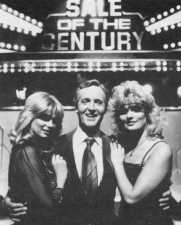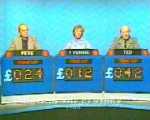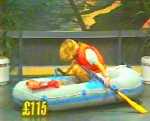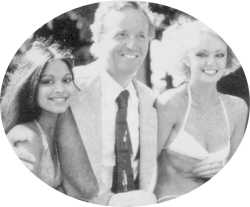Sale of the Century
m (→Pictures) |
m (→Broadcast) |
||
| Line 30: | Line 30: | ||
Challenge TV, 1997 | Challenge TV, 1997 | ||
| - | Granada London for ITV1, 2005 | + | Granada London for ITV1, 8th October 2005 |
</div> | </div> | ||
Revision as of 18:24, 13 June 2006

Contents |
Host
Wilfred Pickles
Co-hosts
Hostesses included: Sophie Batchelor, Eunice Denny, Laura Beaumont, Caro Greenwood, Christine Owen (all in 1978); Carole Ashby, Karen Loughlin (both 1983)
Voiceovers: John Benson (original), Robin Houston (1997)
Organist: Peter Fenn (original version)
Broadcast
ITV (Anglia), 19 Feb 1972-13 Nov 1983 (374 Episodes)
Sky One, late 80s - early 90s
Challenge TV, 1997
Granada London for ITV1, 8th October 2005
Synopsis
"It's the Quiz of the Week!" announced a rather over-enthusiastic John Benson voice-over, while we watched a rotating piece of tin sculpture (the Anglia rider-on-horseback logo... allegedly) swivel gracefully in all its chrome and Brasso glory.
While we look on the programme with equal mixtures of affection and ridicule (more the latter when looking at these archive photos), it's easy to forget that... er... never mind. Ah yes! That it was one of the longest running quiz programmes in living memory. Sure, it didn't clock up the 25 years of, say, the original version of Mastermind but we'd rather have Nicholas Parsons than Magnus Magnusson any day. On television, we mean.
Countless thousands of programmes have been made of this show. Given the consumerist nature of the format (earn cash, spend money on vastly-discounted prizes), it's not surprising that the original format came from America. The industry juggernaut we call Grundy Television took the format over to Australia, where it debuted in 1980. The highest amount ever won by a single contestant was in 1992 when a 26-year-old university student scooped AUS$676,790, which included a $508,000 cash jackpot - a record win for a quiz show in Australia. Students, eh?
 Nicholas Parsons (centre) and friends
Nicholas Parsons (centre) and friendsRather more meek offerings were on Sale in the version best known to most people in the UK, hosted by Nicholas Parsons. To those reading this outside the UK, Parsons is one of those characters who you don't readily associate with being a babe magnet but, judging from the pictures shown here, in the 1970s he must have been quite a catch.
 1970s contestants throb with excitement at winning a total of £78.
1970s contestants throb with excitement at winning a total of £78.SotC is one of the most global formats around - versions have been produced in the US (NBC), New Zealand (TVNZ), Germany (Tele 5), Paraguay (Canal 9), Greece (Star Channel), and Hong Kong (ATV). Currently, British audiences can see a new version of the show on Challenge TV.
The Cheggers Years
The most recent format, shown on Challenge TV for a few years (though as far as we know they only made one series) was rather a blend of the first and second editions of the classic Sale of the Century format. There were six rounds in all. Three contestants started with 15 Sale of the Century pounds, and the game consisted of a sequence of questions each with an assigned cash value. Contestants won this amount by answering questions correctly, or lost it by answering questions wrongly.
We trotted through the rounds at a fair pace. Round one had eight £1 questions. Round two had eight £3 questions, as did round three. Round four had eight £5 questions, but here the questions were reasonably difficult, as opposed to the first few rounds which were all definite jump-ins. Round five had ten £5 five-pound questions, and the last round had 60 seconds' worth of questions for £5 questions of variable difficulty.
 Host, Keith Chegwin
Host, Keith ChegwinAfter each of the first five rounds, you got an instant bargain - a discounted prize which any player could "buy" by buzzing in. A typical show's prizes might be:
- a £70 rucksack for only £6
- a £80 steam iron for only £8
- a £150 small library for only £14
- a £175 wheeled suitcase for only £17
- a £230 palmtop Casio for just £22
 Buzz in for this bargain.
Buzz in for this bargain.The host, Keith Chegwin (pictured), acted like he was on a permanent sugar rush, but was never objectionable or offensive. Perhaps he had too much fun. A minor quibble was that he didn't run the speed-up round with the pace it needed, even filling in the second half of an answered interrupted question while the clock was still running. He was a lot better with the contestants in their introductions than most around, and gained their confidence quickly.
As ever, a selection of more-expensive prizes were available in the Sale of the Century for the winner, though several shows' earning of SotC£ were needed to win them. Top prize might be a £10,000 family car for 500 of your Sale of the Century pounds, then a £4,700 Australia holiday for £409, a £1,075 pair of mountain bikes for £200-odd, a £500 set of golf clubs for £126, and just snuck in at the bottom a £230 microwave oven for £47.
Style challenge
The set was good but simple. Two quarter-circular doors on a semi-circular path split away to KC's left to reveal the prizes, and the big Sale of the Century doors at the back split open at the end. It was done in tasteful pastel pink and purple, and wobbled entertainingly occasionally. The theme music was a mellow remix of the old British Sale of the Century music, and was rather pleasant. Not terribly aggressive. You'd like it. The opening sequence was American in its simplicity as opposed to the (then) very high-tech graphics of the British '70s original.
It was probably as good as it really could have been, to be honest. There was no accumulating cash jackpot, and no chance to win everything-on-the-stage, but maybe that's where budget considerations started to bite. As an alternative to offering bargain price reductions, it might have been nice to see Keith offer some sterling cash with the bargains as an alternative.
It was a show to enjoy watching and playing along with at home.
Catchphrases
"From Norwich, it's the quiz of the week!"
Inventor
Devised by Al Howard (see also: Supermarket Sweep)
Theme music
A music clip is available from the Vintage TV themes site.
Trivia
The Independent Television Authority watchdog reprimanded the programme in 1971 because it thought the show "gloated over the high value of its prizes too much".
An all-out strike at the BBC on 22nd December 1978 meant that 21.2 million viewers watched the programme, the highest ever rating for an ITV game show.
When the original programme stopped in 1983, it had collectively awarded 500 contestants over £500,000 in prizes.
Celebrity editions were run occasionally, with the prizes won going to nominated charities. One example from 1981 featured Tom O'Connor, Nicholas Parsons and Derek Batey as contestrants.
Did you know that the man playing at the organ during the prize descriptions, Peter Fenn, was also Anglia TV's resident managing director?
David Self became the question setter of the Anglia version in September 1976 and continued to set 140 questions for each show each week. If Nicholas didn't get through at least 120 questions, there was little hope of a contestant being able to afford a major prize.
Web links
Pictures
 Picture 1 - Nicholas Parsons with even more hostesses.
Picture 1 - Nicholas Parsons with even more hostesses.
